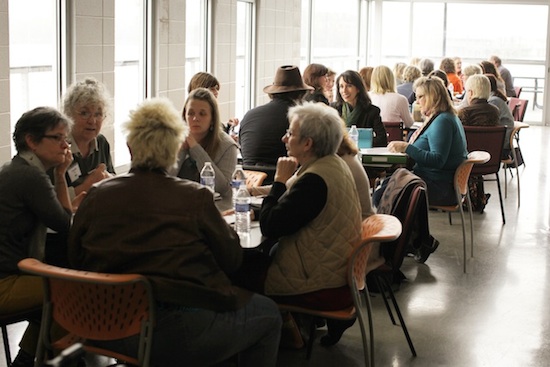One of the biggest excuses artists give for not being in more frequent contact with their lists is that they don’t want to bother people. You know what it’s like to receive tons of email and don’t want to contribute to the overwhelm.
I understand. Even though everyone on your list has opted in to hear from you, it still doesn’t feel right to email so many people if you haven’t established a marketing groove.
There’s a solution: Send emails only to people for whom they are appropriate.
In other words, target your messages rather than sending every email to every person on your list.

All of the attendees at my Nashville workshop are grouped together on my list. Photo courtesy of Mary Claire Crow
Email marketing platforms like Constant Contact, MailChimp, and Emma have the capability to segment an email list. If you haven’t used this feature, the first step is to research how to segment a list inside of your email platform of choice.
How I Segment My List
My email list is segmented automatically when someone purchases something from me. When I have an update for that product – usually in the form of a related blog post or article – I can send the information only to those people.
This segmentation by purchase means I also have buyers’ locations, which allows me to pull up names by state, province, or zip code.
Your segmentation might not be as automated as mine since most artists’ online shopping carts aren’t connected to their email platforms. Even so, it’s worth your time to consider taking these steps.
5 Ways to Slice and Dice Your List
Each artist has his or her own unique circumstances that should be considered when segmenting a list.
Interests
If you make more than one line of work, consider dividing your list according to customer interests. For example, add all of the jewelry patrons to one list and functional pottery patrons to another list.
Buyers of Specific Products
Group everyone who purchases your e-book about mixing color in one list and those who buy your iPhone cases in another. Your sales volume determines how deep you go with the product level segmentation.

Everyone who buys a copy of my book from me is grouped together in my list. This is Eszter Rajna reading my book in the elegant tea lounge at the Randolph Hotel in Oxford.
Collectors
Collectors are people who have purchased a significant amount, whether in dollars or in quantity, from you. These are no doubt your VIPs that you want to treat especially well.
Students
Selling a service is much different than selling fine art. Because of this, you’ll get better results by grouping students together and further segmenting them according to their learning levels, geographical location, and interests.

All of the artists who started an Art Biz Coach marketing salon are grouped together in my list. This is a photo of the “Frozen Chosen” salon in Fairbanks, Alaska.
Geographical Region
The less information you ask people when they sign up for your list, the more likely they are to sign up. I ask for first name and email only. Over time, you can accumulate more information, such as location.
Segmenting lists by geography comes in handy when you do arts festivals or teach out of state. I live in a state (Colorado) where artists from around the country visit for our summer arts festivals. And, yet, I rarely know they’re here in advance.
Are you segmenting your list? Tell us how you slice and dice your names and how you use the various groups.
SOURCE: Artist Business-Building Strategies – Read entire story here.